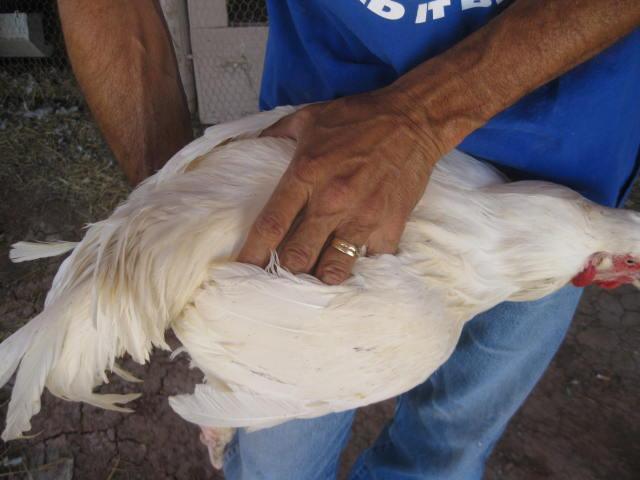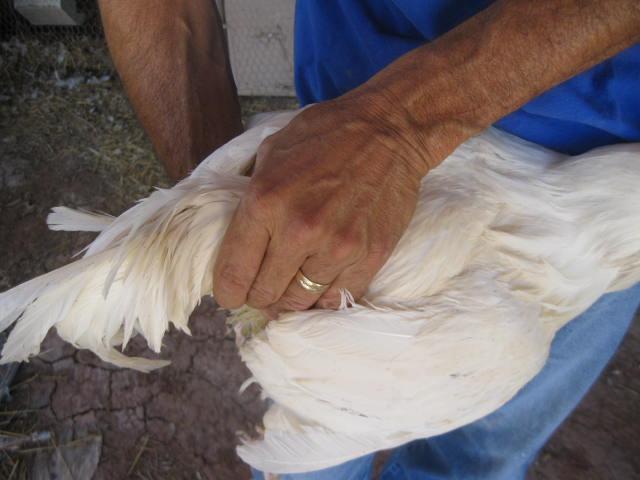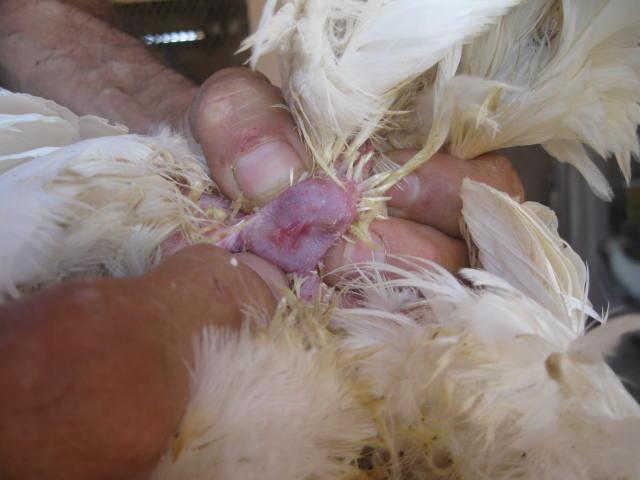Navigation
Install the app
How to install the app on iOS
Follow along with the video below to see how to install our site as a web app on your home screen.
Note: This feature may not be available in some browsers.
More options
You are using an out of date browser. It may not display this or other websites correctly.
You should upgrade or use an alternative browser.
You should upgrade or use an alternative browser.
Red Laced Cornish X and project talk (pics p. 8)
- Thread starter KatyTheChickenLady
- Start date
- May 13, 2008
- 10,684
- 193
- 321
Here is a simple AI procedure in a step by step photo sequence.
The Hulk in postion, I am right handed so my right hand goes under his belly between his leg's and his body held close but not tight to my body.

Start by stroking slightly firm along the back and sides from the shoulders toward the tail, keeping your fingers under his wings.


Now once you have stroked the back a few times lifting the tail at each pass, slide your thumb up to right under the vent, and using your thumb and fore finger of your left hand. Squeeze from the 3 sides firmly to extend the insides of the vent, now just apply some presure and he should give the sample. Collect it with the fingernail of your right hand, it will stay put on the nail.

Now the same procedure apply's to the hen, and when the vent is extended you will see a deeper red slit to the left of the larger opening, this is the spot to now swipe a portion of the sample from the fingernail. Release the presure from the vent and it will then get retracted back into the vent.


So I know the pic's could be better but my helper is just getting the hang of photoing chickens privates LOL.
One full thumbnail sample can fertilize 3-4 hens and you can do this as often as every 3 day's, but a single application can fertilize eggs for up to 2 wk's.
AL
The Hulk in postion, I am right handed so my right hand goes under his belly between his leg's and his body held close but not tight to my body.

Start by stroking slightly firm along the back and sides from the shoulders toward the tail, keeping your fingers under his wings.


Now once you have stroked the back a few times lifting the tail at each pass, slide your thumb up to right under the vent, and using your thumb and fore finger of your left hand. Squeeze from the 3 sides firmly to extend the insides of the vent, now just apply some presure and he should give the sample. Collect it with the fingernail of your right hand, it will stay put on the nail.

Now the same procedure apply's to the hen, and when the vent is extended you will see a deeper red slit to the left of the larger opening, this is the spot to now swipe a portion of the sample from the fingernail. Release the presure from the vent and it will then get retracted back into the vent.


So I know the pic's could be better but my helper is just getting the hang of photoing chickens privates LOL.
One full thumbnail sample can fertilize 3-4 hens and you can do this as often as every 3 day's, but a single application can fertilize eggs for up to 2 wk's.
AL
Thanks Al.
Quote:
My project is about breeding a blue/green egg laying, dual purpose bird with good winter hardiness. I want to keep the pea combs and muffs/beards from the Ameraucanas because they contribute to the Ameraucana's ability to go through hard winters when necessary. I even considered feathered legs; but don't want the added hassle to processing [legs and feet are great dog treats and many use them for soups], and to be honest I just don't like them........................... they give me the willies.

ETA: I'm still growing baby chicks in a mosquito tent when they first go outside at 3 weeks, but started moving older chicks to a portable breeding/growing pen on grass. There are enough blackflies left to cause them to scratch or shake their heads occassionally, but no longer a threat. Evidently the information the people who have lived here in the river bottoms long term was correct; the major hatch only lasts about two weeks with this local subspecies................................. after that they are just a bit of a nuisance for the remainder of the summer. We had a minor Mayfly hatch last week, but their no threat to animals; however, in the past, I've seen them so thick on the bridge crossing the Mississippi River that they closed it untill either useing a snowplow or firetruck to clear it. [Can you imagine?]
My project is about breeding a blue/green egg laying, dual purpose bird with good winter hardiness. I want to keep the pea combs and muffs/beards from the Ameraucanas because they contribute to the Ameraucana's ability to go through hard winters when necessary. I even considered feathered legs; but don't want the added hassle to processing [legs and feet are great dog treats and many use them for soups], and to be honest I just don't like them........................... they give me the willies.

ETA: I'm still growing baby chicks in a mosquito tent when they first go outside at 3 weeks, but started moving older chicks to a portable breeding/growing pen on grass. There are enough blackflies left to cause them to scratch or shake their heads occassionally, but no longer a threat. Evidently the information the people who have lived here in the river bottoms long term was correct; the major hatch only lasts about two weeks with this local subspecies................................. after that they are just a bit of a nuisance for the remainder of the summer. We had a minor Mayfly hatch last week, but their no threat to animals; however, in the past, I've seen them so thick on the bridge crossing the Mississippi River that they closed it untill either useing a snowplow or firetruck to clear it. [Can you imagine?]
Last edited:
Somewhat off topic, but thought SteveH might have some insight. Posted also on the egglaying forum.
I have been getting 2 odd looking eggs from my hens each day for some weeks now. The shells are extremely fragile; they have a very rough, pitted pointy end, and sometimes there are tiny bits of shell on the inside of the egg.
The hens have oyster shells free choice, and are all free range birds. I have 12 hens; the two laying these odd eggs are Ameruacana(EE), one is a purebred the other an F1 hybrid Buff Orp/Ameruacana. We have identified one as a young hen, about 14 moths old, the other is about 2 1/2 years.
Is this some kind of disease, or is it a nutrient deficiency? They are getting layer rations; on free range pasture, and I give them snacks/treat in the afternoon, of fresh kitchen foods: lettuce, quinoa, yogurt, dried milk powder, oats, tomatoes, fruit etc.
They get the same foods as the other hens - BR's, Wyandottes, Polish, 'Lorps; but the others are doing fine.
Anybody have any ideas or had this too - how did you fix it, or should these hens be "retired"?
TC - thanks
I have been getting 2 odd looking eggs from my hens each day for some weeks now. The shells are extremely fragile; they have a very rough, pitted pointy end, and sometimes there are tiny bits of shell on the inside of the egg.
The hens have oyster shells free choice, and are all free range birds. I have 12 hens; the two laying these odd eggs are Ameruacana(EE), one is a purebred the other an F1 hybrid Buff Orp/Ameruacana. We have identified one as a young hen, about 14 moths old, the other is about 2 1/2 years.
Is this some kind of disease, or is it a nutrient deficiency? They are getting layer rations; on free range pasture, and I give them snacks/treat in the afternoon, of fresh kitchen foods: lettuce, quinoa, yogurt, dried milk powder, oats, tomatoes, fruit etc.
They get the same foods as the other hens - BR's, Wyandottes, Polish, 'Lorps; but the others are doing fine.
Anybody have any ideas or had this too - how did you fix it, or should these hens be "retired"?
TC - thanks
Quote:
I've gotten porous eggs and eggs with what look to be a shell fragment added to the outside of eggs, but never inside; and "fart" eggs [tiny little eggs maybe a half inch across with no yolks inside], and shelless eggs. The shelless and fart eggs came from new layers; the worst quality shells came from new layers as they stepped production to full capacity last fall just before I wormed them...................... but not sure if it was worming that helped or if they just started taking up enough calcium to keep with egg production. I was useing ground lime stone last summer and fall; but added recycled crushed egg shells and oyster shell mixed and offered free choice. The egg with what look to be a piece of shell fragment added to the outside quit appearing when I traded my Speckled Sussex to my neighbor.
 The last Ameraucana eggs laid as the buffalo gnats reached plague population were getting porous, so stress may have been a factor; and of the three porous eggs I tried to hatch, only one hatched. Of the worst two, one was rotten, the other quit a a day or two before hatch [judging by the huge, unabsorbed yolk]. Isn't vitamin D needed for calcium absorption?
The last Ameraucana eggs laid as the buffalo gnats reached plague population were getting porous, so stress may have been a factor; and of the three porous eggs I tried to hatch, only one hatched. Of the worst two, one was rotten, the other quit a a day or two before hatch [judging by the huge, unabsorbed yolk]. Isn't vitamin D needed for calcium absorption?
I've gotten porous eggs and eggs with what look to be a shell fragment added to the outside of eggs, but never inside; and "fart" eggs [tiny little eggs maybe a half inch across with no yolks inside], and shelless eggs. The shelless and fart eggs came from new layers; the worst quality shells came from new layers as they stepped production to full capacity last fall just before I wormed them...................... but not sure if it was worming that helped or if they just started taking up enough calcium to keep with egg production. I was useing ground lime stone last summer and fall; but added recycled crushed egg shells and oyster shell mixed and offered free choice. The egg with what look to be a piece of shell fragment added to the outside quit appearing when I traded my Speckled Sussex to my neighbor.

- Thread starter
- #1,057
I always dose with PolyViSol and that goes right away; therefore I am assuming Steve is right about the need for Vitamin D.
Al - great info saving my comments until tonight when I have more time.
Al - great info saving my comments until tonight when I have more time.
Quote:
I've gotten porous eggs and eggs with what look to be a shell fragment added to the outside of eggs, but never inside;>...<The egg with what look to be a piece of shell fragment added to the outside quit appearing when I traded my Speckled Sussex to my neighbor.
 The last Ameraucana eggs laid as the buffalo gnats reached plague population were getting porous, so stress may have been a factor; and of the three porous eggs I tried to hatch, only one hatched. Of the worst two, one was rotten, the other quit a a day or two before hatch [judging by the huge, unabsorbed yolk]. Isn't vitamin D needed for calcium absorption?
The last Ameraucana eggs laid as the buffalo gnats reached plague population were getting porous, so stress may have been a factor; and of the three porous eggs I tried to hatch, only one hatched. Of the worst two, one was rotten, the other quit a a day or two before hatch [judging by the huge, unabsorbed yolk]. Isn't vitamin D needed for calcium absorption?
Hmmm, I didn't see any signs of worms - do you worm on a regular basis or only when you observe them?
Stress; we have had some hawks around lately, hauling off ducklings and chicks - it's a possibility; hawks seem to be gone now that the remaining chicks are too old to "lift". But then, I would have thought it would stress ALL the birds!
Vitamin D - I'll give it a try; I was attempting to up their vitamins by adding the yogurt and dry milk powder.
I've got nothing against retirement, but this Ameraucana was my personal favorite.
You seem to be getting back on your feet - glad to see it!

I've gotten porous eggs and eggs with what look to be a shell fragment added to the outside of eggs, but never inside;>...<The egg with what look to be a piece of shell fragment added to the outside quit appearing when I traded my Speckled Sussex to my neighbor.

Hmmm, I didn't see any signs of worms - do you worm on a regular basis or only when you observe them?
Stress; we have had some hawks around lately, hauling off ducklings and chicks - it's a possibility; hawks seem to be gone now that the remaining chicks are too old to "lift". But then, I would have thought it would stress ALL the birds!
Vitamin D - I'll give it a try; I was attempting to up their vitamins by adding the yogurt and dry milk powder.
I've got nothing against retirement, but this Ameraucana was my personal favorite.
You seem to be getting back on your feet - glad to see it!

Quote:
Aha! Going out to the store this pm, will stop by the feedstore and pick some up.
TC (BTW, I'm another Katie)

Aha! Going out to the store this pm, will stop by the feedstore and pick some up.
TC (BTW, I'm another Katie)

- Thread starter
- #1,060
PoliVySol is a human infant vitamin - you can find it at places like Walmart or Rite Aid. It is liquid and comes with a dropper. It is my first line of defense for ANY chicken ailment.
And hello another KATIE . . . AND WELCOME!!!
And hello another KATIE . . . AND WELCOME!!!
Last edited:
New posts New threads Active threads
-
Latest posts
-
-
-
Bumblefoot – is this a good treatment plan?
- Latest: RubelliteRose
-
-
-
-
Latest threads
-
-
-
Guinea fowl neck broken/sprained?
- Started by Em_ily231
- Replies: 1
-
-
-
-
Threads with more replies in the last 15 days
-
-
-
-
Vent gleet/prolapse/abscess? What am I missing
- Started by FreshObsessed
- Replies: 47
-
-
×

